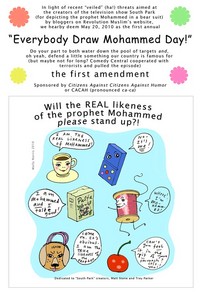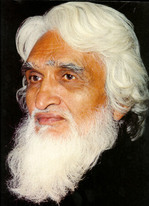That old adage about a picture being worth a thousand words may need to be revised. Pictures of the prophet Muhammad have generated perhaps millions of words this week alone, without even being drawn.
 Today, May 20, has been designated — by the masterminds (?) behind the viral campaign at least — to be Draw Muhammad Day. The campaign, which was originally conceived of as a protest against Comedy Central’s self-censorship of a South Park episode depicting the prophet, has quickly denigrated into a vicious war of words, images, and ideologies. In this corner– religious sensibilities. And in that one: unfettered freedom of expression. Which one should trump?
Today, May 20, has been designated — by the masterminds (?) behind the viral campaign at least — to be Draw Muhammad Day. The campaign, which was originally conceived of as a protest against Comedy Central’s self-censorship of a South Park episode depicting the prophet, has quickly denigrated into a vicious war of words, images, and ideologies. In this corner– religious sensibilities. And in that one: unfettered freedom of expression. Which one should trump?
Ah, if it were only that simple.
Consider that the original promoters of the DMD event have since disavowed it. Seattle cartoonist Molly Norris and Facebooker Jon Wellington have both quickly stepped away from the controversial event. (“I am aghast that so many people are posting deeply offensive pictures of the Prophet…” Wellington reportedly said, “count me out.”) But what does that mean? That Norris and Wellington are back-peddlers, now trying to weasel out of the mess that they started? Or that they’re victims of the very same pressure-to-censor and political-correctness-run-amok that they were trying to speak out against?
What do we make of the fact that Pakistan courts have ordered a blanket block of Facebook (and apparently You Tube too) as a result of the campaign? In going the heavy-handed censorship route, isn’t Pakistan just proving the point for the pro-DMD camp? (Really, Pakistan, you think this will help your image?)
Should Muslims (and others offended by DMD) fight fire with fire, engaging in protests of the protests and Facebook-flame-wars? Or is the higher road here to recognize the DMD’ers right to exercise their artistic freedom — even if it is a freedom to offend — and let them have their day of drawing?
My community struggles with the same tension between faith and freedom, the same concern about lines being crossed, the same tug of war between what the head knows intellectually and the heart feels emotionally.
And so, in that spirit, I’d like to offer an interesting but ironic parallel to the DMD controversy from within the Hindu world. Ironic because the roles seem to be reversed in my example– the artist in this case is himself a Muslim, the offended community Hindu, and the outcome very difference. Which brings us to the curious case of 95-year-old painter M.F. Husain.
Let me clear: in bringing up Mr. Husain, I’m not trying to engage in tit-for-tat. That sort of sectarian justification (“Your religion offended us before you were offended, so you lose…”) has always been something I’ve found particularly repugnant. Being on the receiving end of offense doesn’t give anyone the right to dish it out, and vice versa.
But the fact remains that a side-by-side look at the two cases (DMD and Husain’s controversial paintings of Hindu deities) raises important — albeit uncomfortable — questions about whether or not there might be a double standard at work.
 Once dubbed the Picaso of Indian art, M.F. Husain has made something of a career of pushing the envelope. But he really found himself on the hot-seat in the 1990s when a series of his paintings of Hindu deities was published. The issue was not that Husain depicted these divine subjects. After all, Hinduism is a tradition of sacred imagery, where depictions of Gods and Goddesses are not only produced (even mass-produced) but are celebrated and sometimes actually venerated. No, the problem was that the paintings depicted these personalities in the nude, with a palpable sexual meaning suggested between the strokes. In one famous example, a naked Sita Devi sits on the lap of the demon king Ravana (also nude), while Hanuman (you guessed it — sans-clothes) leaps forward. In another, a naked Goddess Saraswati suggestively straddles the vina. A third implies a sexual relationship between the Goddess Durga and her tiger.
Once dubbed the Picaso of Indian art, M.F. Husain has made something of a career of pushing the envelope. But he really found himself on the hot-seat in the 1990s when a series of his paintings of Hindu deities was published. The issue was not that Husain depicted these divine subjects. After all, Hinduism is a tradition of sacred imagery, where depictions of Gods and Goddesses are not only produced (even mass-produced) but are celebrated and sometimes actually venerated. No, the problem was that the paintings depicted these personalities in the nude, with a palpable sexual meaning suggested between the strokes. In one famous example, a naked Sita Devi sits on the lap of the demon king Ravana (also nude), while Hanuman (you guessed it — sans-clothes) leaps forward. In another, a naked Goddess Saraswati suggestively straddles the vina. A third implies a sexual relationship between the Goddess Durga and her tiger.
Offended Hindus and several Hindu groups began a backlash. In a predictably stupid and counter overreaction, some Hindu fundamnetalists attacked the painter’s home and shut down a London exhibit. Several also filed court cases against Husain. Following the controversy, Husain went on “self imposed exile”. In a post-script, earlier this year, he accepted citizenship of Qatar, making the exile from India a legal reality.
Let me be clear again: I find the way that Hindu extremists responded to Husain to be unequivocally reprehensible and embarrassing. I want to say — no, scream — “that’s not my kind of Hinduism!” Personal attacks, mud-slinging, death threats… I truly believe that all of it goes against the very heart and spirit of my faith, and I think those who do it “in defense of Hinduism” commit the worst sort of violence on the faith– far worse than any “outsider” ever could.
But can I also confess that I was — and am — offended by Husain’s paintings? That even though I think he had a right to paint them, I don’t think he should have? That I might even suggest that Husain’s freedom of expression hinged on a responsibility to respect others, and that he crossed a line when he failed in that responsibility?
By now, this should sound pretty familiar. In fact, you might think that I could probably take any of the numerous articulate and thoughtful critiques of the infamous Danish cartoonist or of South Park or of DMD, do a search-and-replace to change the “who’s who” in the cast of characters, and come out with a robust op-ed challenge to Mr. Husain.
You’d think that, but apparently you’d be wrong.
The frustrating reality is that the Husain case invariably plays out differently. The “good guys” almost always seem to side with the artist, aghast that some thin-skinned religious fanatics should dare to limit his freedom. In this scenario, the intolerant and insensitive jerks aren’t the one’s drawing the offensive stuff, they are the one’s protesting it.
My friends who email me, requesting to join in to their anti-DMD protest, are the very same ones who also beseech me to sign petitions in support of Husain. I just don’t get it.
Is there some inherent difference between Husain’s nude Gods and Goddesses and the results of DMD?
Some might say that Husain was unfairly targeted just because he was Muslim offering his own interpretation of Hindu icons. But couldn’t we say the same about the Danish cartoonist — a non-Muslim offering his own commentary on Islam — or of the South Park folks, or of anyone who picks up their pencil and sketches the prophet today?
Maybe its different because Husain is a recognized artist whose pieces fetch millions of dollars and decorate the homes of the rich and famous, while the cartoonists are, well, cartoonists. But doesn’t that type of judgment call seem a tad elitist?
Of course, the very act of drawing the prophet in any way, shape, or form is anathema to many Muslims. The act itself is offensive to them. The organizers of DMD know this– that’s precisely why they organized the event. While I’d like to believe that Mr. Husain didn’t set out to offend in quite the same way, I still think its pretty reasonable to say that he ought to to have known how hurt some Hindus would be. Husain, it turns out, grew up in a Hindu temple town and had ample opportunity to educate himself about what would and would not offend his Hindu neighbors.
Husain might have been trying to make a statement about Hinduism, or religious fundamentalism, or Indian politics. Fair enough. The folks drawing Muhammad today may be voicing their opinion about censorship. I get that. But why punish innocent people of faith to make ar point?
I won’t participate in Draw Muhammad Day for the same reason that I say that M.F. Husain was wrong. I won’t deny an artist his right to choose how he expresses himself, but I won’t pretend that all choices are created equal. They are not. We choose to uplift or to denigrate, to heal or to hurt. That choice is ours, today and every day.

